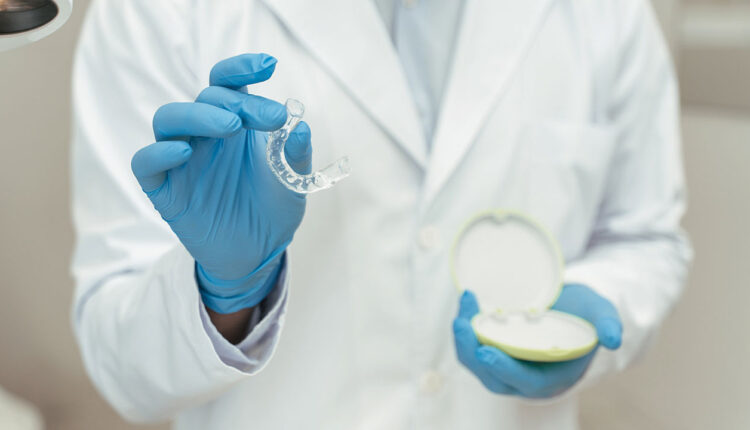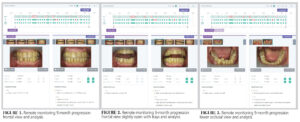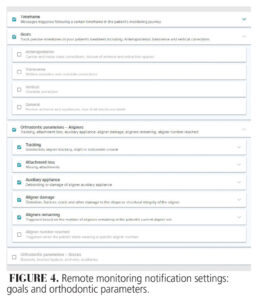
Advances in Orthodontic Monitoring
How to harness digital tools for remote patient assessment.
This course was published in the March/April 2025 issue and expires April 2028. The author has no commercial conflicts of interest to disclose. This 2 credit hour self-study activity is electronically mediated.
AGD Subject Code: 370
EDUCATIONAL OBJECTIVES
After reading this course, the participant should be able to:
- Identify how clear aligner therapy has evolved as a treatment option.
- Describe the role of vibration therapy and remote monitoring in improving aligner seating, treatment tracking, and overall orthodontic outcomes.
- Discuss the potential advantages and limitations of teledentistry and remote monitoring in enhancing patient care, reducing chair time, and improving clinical efficiency.
In 2020, the whole world shut down due to the COVID-19 pandemic, limiting the ability of orthodontists to see their patients regularly. The experience made it clear that finding a way to track patients undergoing orthodontic treatment from afar was key to ensuring positive patient outcomes. Clear aligner therapy (CAT) is considered a safer, more predictable, and more effective treatment modality compared with fixed orthodontic appliances during unprecedented events such as the global pandemic.1
CAT has become an increasingly popular treatment for many patients who want an esthetic option to align their teeth. The global clear aligner market accounted for more than $5 billion in revenue in 2023 and is projected to be over $32 billion by the year 2032.2
In CAT, multiple transparent vacuum-formed trays (primarily made of copolyester or polycarbonate plastic) are designed to incrementally reposition the teeth. Each tray is three-dimensionally (3D) printed using virtual digital models to express the expected tooth movement and guide the teeth to the desired position until the next tray is changed as prescribed by the provider. These setups are completed by dentists and technicians using computer-aided design and computer-aided manufacturing (CAD/CAM) and proprietary software.
Despite the proven clinical effectiveness of clear aligners, finished results do not always match what was designed by the computer simulation. The reason for this discrepancy may be that the aligners are not being seated completely and the teeth are not “tracking” with the trays. Without complete seating, the plastic of the aligner is unable to effectively encompass the tooth and fully express the desired forces.3
Unsuccessful CAT can be attributed to incomplete aligner seating, which is multifactorial and may include limitations in the simulated tooth movement software/technology, patient noncompliance, or use of adjuncts like “chewies” to aid in the seating of trays to facilitate effectiveness of aligners. One way to address compliance is to have a system that confirms aligner wear more regularly than the traditional in-person appointment time intervals, opening the door to remote monitoring of patients undergoing CAT.
Clear aligners have shown success in leveling and aligning arches, controlling anterior intrusion, posterior buccolingual inclinations, and upper molar bodily movements of 1.5 mm or less; however, clear aligners are not as effective in controlling anterior extrusion or buccolingual inclinations and rotations of rounded teeth.4 CAT may produce clinically acceptable outcomes comparable to fixed appliance therapy for buccolingual inclination of upper and lower incisors in mild to moderate malocclusions.5
Vibration Therapy
Several methods have been used to address unsuccessful CAT. To achieve more complete aligner seating, clear aligner treatment may involve vibration therapy and/or having the patient use a “chewy” bite object to help seat the tray better. Various devices are on the market that simultaneously deliver vibration; however, it is not well understood if these devices are effective because they emit vibration, inducing a biological response at the hard and soft tissue levels, or if the bite object helps the trays seat more completely.
One vibration device was reported unsuccessful as an adjunctive treatment to speed up orthodontic tooth movement and decrease orthodontic associated tooth pain.6 Another vibration device with a higher frequency acceleration vibration showed a positive effect on both the anabolic and inflammation-dependent catabolic pathways of bone remodeling.7
In a study that used vibration therapy to evaluate decreased aligner change frequency, there was improved tracking of the teeth when trays were changed every 7 days with the 5-minute vibration compared to 14 days with no vibration.8 This research suggests that vibration therapy could shorten treatment time by reducing tray change intervals. One of the primary questions that remains is whether the improved tracking of teeth with vibration therapy is due to enhanced seating from the device or whether it induces a biological response augmenting the speed of tooth movement.
Teledentistry
Teledentistry uses technology to share information, images, and audio files.9 Teledentistry can be used in the consultation, diagnosis, and treatment planning process in addition to monitoring and fabricating appliances for patients in active treatment.9 Teledentistry and the ability to remotely monitor active patients have potential to improve access to care, reduce costs to the patient and provider, and manage patients with less chair time.
A survey study showed that dentists, orthodontists, and orthodontic patients all positively judged telemonitoring and its use in orthodontic treatment, finding its value as a technologically advanced tool to increase the perception of quality and accuracy of treatment.10 Evidence supports the efficacy of teledentistry, but more research is needed to make evidence-based policy decisions on teledentistry focused on its effectiveness, cost-effectiveness, and long-term usage.11 Teledentistry may allow for improved individualization and optimization of orthodontic treatment with new technologies.
Remote Monitoring
New technologies have come into practice in the orthodontic and dental markets to remotely monitor patients. Like the clear aligner market, many companies produce remote monitors with various uses and capabilities. These monitors are equipped with impressive software capabilities and artificial intelligence (AI).
Remote monitors are used to analyze the seating of clear aligners and the tracking of teeth during orthodontic therapy. No significant differences exist between 3D digital dental models made from remote monitor scans and those created with traditional intraoral scanners.12 More specifically, software measurements of intercanine and intermolar widths after palatal expansion were within 0.5 mm of in-office direct measurements on plaster study models.13
The ability of remote monitors to accurately measure linear tooth movements helps the practitioner make reliable clinical decisions prior to seating the patient in the chair. Other studies demonstrated the usefulness of remote monitoring to rapidly detect any movement errors during various type of cases including, but not limited to a patient undergoing orthognathic surgery followed by corticotomy-accelerated aligner therapy, interceptive treatment in a growing patient, and an adult anterior crossbite patient, facilitating the providers to correct more complex movements.14,15
Additionally, Impellizzeri et al16 found that the use of remote monitoring in patients using fixed orthodontic appliances was advantageous compared to those in traditional treatment protocols; patients using monitors required less chair time, reduced material costs, fewer visits, and a more precise evaluation of treatment by the practitioner due to the high frequency of monitoring scans.
Another study showed that patients undergoing CAT while using a remote monitor had significantly reduced number of appointments.17 Hansa et al18 later showed that dental monitoring with CAT achieved similar clinical accuracy in 1.7 fewer months compared with control groups, suggesting improved aligner tracking in patients that used monitoring.
One of the advantages of remote monitors is that they objectively determine when patients can switch to the next tray in their treatment protocol. Many practitioners decide on arbitrary change frequencies ranging from 7 to 14 days, whereas patients using monitoring can potentially switch as much as every 4 days. A recent study showed that 14-day changes were significantly more accurate in achieving certain posterior movements such as intrusion, but patients utilizing a 7-day change frequency achieved clinically similar accuracies in overall desired tooth movements.19 However, a limit or maximum threshold regarding aligner change frequency has not been established and may be individualized and customized on a case-by-case basis, particularly with remote technologies.
Utilization of Remote Monitoring in Clinical Practice
The combined efforts of remote monitors and vibrational therapy can optimize individualized tray change intervals for aligner patients, ultimately making treatment more efficient. Following an arbitrary 7- to 14-day tray change interval may be unnecessary in certain mild to moderate malocclusions or during refinements or revisions of patients who are well in active treatment. The combination may also give patients more flexibility in wearing aligners less frequently than the standard full-time protocols as long as the monitor reports proper fitting of the trays.
The case in Figures 1 and 2 shows progress over 9 months in a periodontally compromised adult. In Figure 1, the scan timeline at the top of the image displays an up-to-date course of treatment defined by which aligner number the patient is on. Overbite, overjet, and midline deviation are also measured and shown as well.
Slight unseats already present at tray 1 (upper left 1 = UL1/tooth #9, upper left 2 = UL2/tooth #10, lower left 2 = LL2/tooth #23, lower right 1 = LR1/tooth #25) indicating more of a potential manufacturing and fit issue of the aligners, but not a flaw in the monitor itself. Also note the UL2 and LR2 slight unseats were ignored as these teeth had not been tracking well but not affecting the clinical progress of the case.
Specific teeth can be intentionally excluded so that the monitor does not force a patient to stay longer on one tray for an unnecessary amount of time. This is a customizable feature that allows clinicians to individualize their use of the technology. One of the limitations of some of these devices is it can be difficult to capture upper and lower occlusal photos for many patients (Figure 3), but this information is not critical to demonstrate treatment progress or evaluate tracking and tray fitting metrics. Other metrics that can be evaluated are shown in Figures 4 and 5. Patients can also directly message the provider with questions or concerns which can enhance a patient’s experience and comfortability during treatment.
The remote monitoring devices designed for dentistry have many uses including but not limited to evaluation of compliance with appliances (eg, expanders and mandibular advancement appliances), oral hygiene assessment, oral cancer screening, and monitoring of retainer wear post-orthodontic treatment. Remote monitoring can encourage compliance with proper aligner wear and, ultimately, quality control if patients know they are constantly under observation by their dentist beyond in-office visits.
Wearing aligners for the recommended amount of time and ensuring they fit properly as patients transition between trays may help reduce treatment time. However, no research has proven that remote monitoring shortens the overall treatment duration. Remote monitoring may reduce emergency appointments and although this has not shown to be the case, it may allow clinicians to identify emergencies more readily and accurately so that they can remedy these situations more efficiently, even making decisions remotely. This allows for a more personalized, proactive, and preventive approach instead of a reactionary and curative dynamic.20
Direct communication and access to images facilitate dentist-patient connections to find more immediate solutions. This can also benefit patients in retention after active treatment to continue monitoring potential relapse with limited or without office visits; this was critical during the COVID-19 pandemic to avoid unnecessary in person evaluations.21
Conclusion
Remote monitoring offers various benefits for case management and efficiency, but its use should be evaluated individually for each patient. Remote monitoring products have a lot of potential but due to limitations in how scans are analyzed and processed, consistent and regular dentist visits with in-person evaluations cannot be replaced. Supervision by experienced clinicians is still necessary as these technologies are not full-proof and 100% accurate. Ferlito et al22 showed inconsistencies in the remote monitoring instructions when multiple scans were taken consecutively on an individual patient. The lack of repeatability and reproducibility of the dental monitors suggest limitations in the AI and algorithms used to determine a patient’s tracking status.
If a remote monitor is used to track aligner seating and fit, the difficulty of the movements must be considered as there is a higher probability of tracking issues if the planned movements are not as favorable or predictable for the clear aligners (eg, extrusion of anterior teeth, large rotations of premolars, upper incisor torque, etc). The combination of thorough clinical evaluation in conjunction with the use of AI through remote monitoring may provide an optimal way to manage both orthodontic and dental cases while delivering favorable outcomes and positive patient experiences.
To take full advantage of the favorable aspects of remote monitoring, the artificial intelligence, software, and deep learning algorithms built into these devices must continue to improve and show more consistency. Although many clinicians are having success and positive experiences utilizing remote monitors in their daily practice, more research is needed to confirm the evidence-based value of remote monitors on providing accurate feedback and better clinical results.
References
- Kaur H, Kochhar A, Gupta H, Singh G, Kubavat A. Appropriate orthodontic appliances during the COVID-19 pandemic: A scoping review. J Oral Biol Craniofac Res. 2020;10:782-787.
- Straits Research. Global Clear Aligners Market Size, Share, CAGR of 23.1%, Report to 2023. Available at https://straitresearch.com. Accessed March 5, 2025.
- Shipley T. Vpro5™ — more efficient aligner seating with high-frequency vibration. Available at orthoprac/ iceu/.com/ vpro5-efficient-aligner seatinghigh-frequency-vibration/ . Accessed March 7, 2025.
- Rossini G, Parrine , Castroflorio T, Deregibus A, Debernardi CL. Efficacy of clear aligners in controlling orthodontic tooth movement: a systematic review. Angle Orthod. 2015;85:881-889.
- Robertson L, Kaur H, Fagundes NCF, Romanyk D, Major P, Mir CF. Effectiveness of clear aligner therapy for orthodontic treatment: A systematic review. Orthod Craniofac Res. 2020 May;23(2):133-142.
- Katchooi M, Cohanim B, Tai S, Bayirli B, Spiekerman C, Huang G. Effect of supplemental vibration on orthodontic treatment with aligners: A randomized trJ l. Am J Orthod Dentofacial Orthop. 2018;153:336-346.
- Alikhani M, Alansari S, Hamidaddin MA, et al. Vibration paradox in orthodontics: anabolic and catabolic effects. PLoS One. 2018;13:e0196540.
- Alansari S, Atique MI, Gomez JP, et al. The effects of brief daily vibration on clear aligner orthodontic treatment. Journal of the World Federation of Orthodontists. 2018;7(4):134-140.
- Kravitz ND, Burris B, Butler D, William DC. Teledentistry, do-it-yourself orthodontics, and remote treatment monitoring. J Clin Orthod. 2016;12:718-726.
- Dalessandri D, Sangalli L, Tonni I, et al. Attitude toward telemonitoring in orthodontists and orthodontic patients. Dent J (Basel). 2021;9:47.
- Estai M, Kanagasingam Y, Tennant M, Bunt S. A systematic review of the research evidence for the benefits of teledentistry. J Telemed Telecare. 2018;24:147-156
- Kaur H, Kochhar AS, Gupta H, Singh G, Kubavat A. Appropriate orthodontic appliances during the covid-19 pandemic: a scoping review. J Oral Biol Craniofac Res. 2020;10:782-787.
- Morris R, Hoye L, Elnagar M, et al. Accuracy of dental monitoring 3D digital dental models using photograph and video mode. Am J Orthod Dentofacial Orthop. 2019;156:420-428.
- Moylan H, Carrico CK, Lindauer SJ, Tufekci E. Accuracy of a smartphonebased orthodontic treatment-monitoring application: A pilot study. Angle Orthod. 2019;89:727-733.
- Hannequin R, Ouadi E, Racy E, Moreau N. Clinical follow-up of corticotomy-accelerated Invisalign orthodontic treatment with dental monitoring. Am J Orthod Dentofacial Orthop. 2020;158:878-888.
- Impellizeri A, Horodinsky M, Barbato E, Polimeni A, Phillipe S, Gallucio G. Dental monitoring applications: it is valid innovation in the orthodontics practice? La Clinica Terapeutica. 2020;171(3):e260-270.
- Hansa I, Semaan SJ, Vaid NR. Clinical outcomes and patient perspectives of Dental Monitoring® GoLive® with Invisalign®-a retrospective cohort study. Prog Orthod. 2020;21:16.
- Hansa I, Vandana K, Ferguson DJ, Vaid N. Outcomes of clear aligner treatment with and without Dental Monitoring: A retrospective cohort study. Am J Orthod Dentofacial Orthop. 2021;159:453-459.
- Al-Nadaw, M, Kravitz ND, Hansa I, Makki L, Ferguson DJ, Vaid NR. Effect of clear aligner wear protocol on the efficacy of tooth movement. Angle Orthod. 2021;91:157-163.
- Batra P, Tagra H, Katyal S. Artificial intelligence in teledentistry. Discoveries. 2022;10(3):3153.
- Sangali L, Alessandri-Bonetti A, Dalessandri D. Effectiveness of dental monitoring system in orthodontics: a systematic review. J Orthod. 2023;5:28-40.
- Ferlito T, Hsiou D, Harget, K, et al. Assessment of artificial intelligencebased remote monitoring of clear aligner therapy: A prospective study. Am J Orthod Dentofacial Orthop. 2023;164:194-200.
From Decisions in Dentistry. March/April 2025;11(2):32-35.







